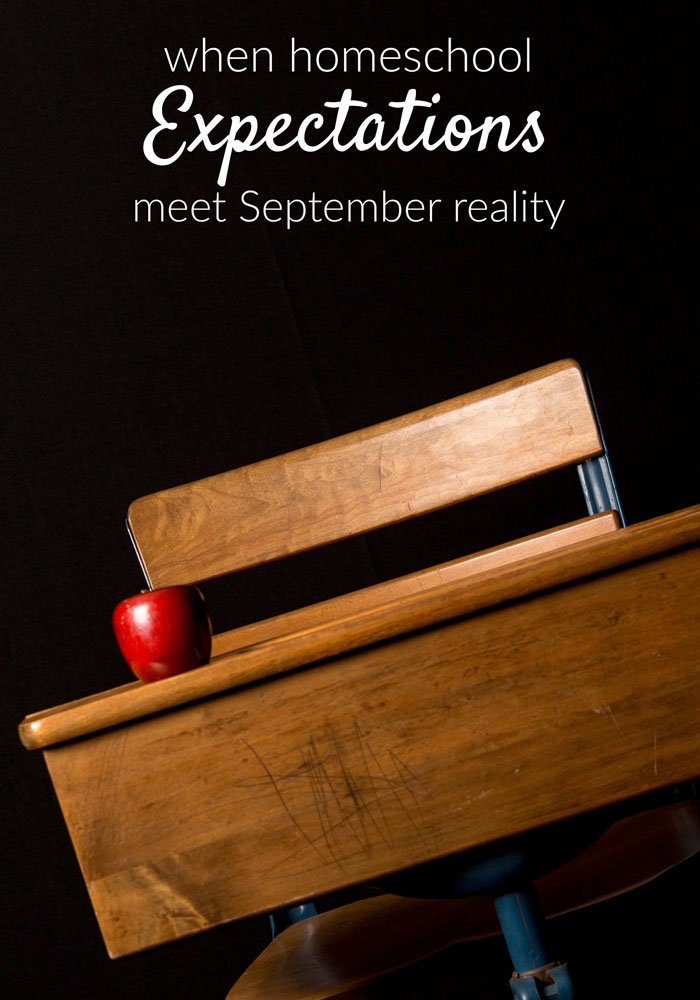
You spent your summer planning. You did your research, shopped the sales, and cross-referenced all the books and materials you already had on hand. You have charts and sticky notes in all the right places.
You’ve got fresh ideas and a fresh new approach. No kid has been blessed with such an amazing educational experience as your kiddos are about to experience.
You can’t wait to introduce them to all the wonders of this brand new homeschool year! And then, expectation meets reality.
New Habits Take Time
When it seems like everything is falling apart in the first week, don’t loose heart. Remember that it takes time to establish new routines.
Before the school year even begins, pull out your calendar and put a big red star on a date that’s about eight weeks into the year. Here’s why.
I once read that to learn a new skill, fact or habit, you need to do it correctly seven times in a row. That means that if there’s something you do once a week, you should expect it to take about seven weeks to become the regular routine.
[thrive_leads id=’49917′]
I also read that if you learn something incorrectly (like memorize the wrong answer to a multiplication problem) you have to do it correctly twenty-one times to overcome the previous error.
Of course, this doesn’t only apply to “wrong” and “right” but also to “the way we used to do it” and “the new way we’re doing it” (or “summer schedule” versus “school schedule”).
So even if this new practice is part of your daily routine, it will take more than four weeks for the kids (and you!) to have done it at least twenty-one times the new way.
And how long will it take to do it twenty-one times in a row correctly? Well, that might not ever happen! But the point is to give your system time to settle in before you deem it a complete failure!
It Looked so Good on Paper
Sometimes when we’re planning for a new year, we fall into the trap of focusing on what we feel “should” be covered. Yes, there are requirements and guidelines we need to consider.
And of course, we want to be diligent in providing our children with a well-rounded education.
But when you’re only interacting with books and planning pages, it’s easy to forget about the real live people you’re planning for. Sometimes we plan based on what we think they “should” be able to do without regards to what they actually are capable of doing.
Maybe you felt your student “should” be able to sit and listen for this period of time or “should” be able to read this book independently or “should” be able to write four complete sentences altogether.
But in some ways, those benchmarks are kind of irrelevant. You can’t plan for what “should” be, only for what is. There’s nowhere to start but where you are.
Even when we do manage to keep this perspective intentionally in mind, our concept of our child’s ability or maturity may not actually mesh with reality.
If your plan reveals that your child isn’t ready for what you thought he would be, consider it an opportunity. By trying something new, you’ve just revealed an area where he could benefit from some extra practice or support.
This is What Homeschooling is All About
It’s tempting to feel like you’ve failed when you have to change the schedule … or even the curriculum! It’s easy to start second-guessing yourself. If only you’d done more research. If only you’d considered these other factors. If only you really knew what you were doing!
But friend, let me remind you why it can actually be a blessing to find yourself in this situation. What’s happening here is that you’ve got the unique opportunity to experience first-hand what your kids need, what’s really helpful, and what isn’t. And as a homeschooler, you’ve got the power to do something about it.
Though it may be a lot of trouble to change plans mid-stream, your ship is a lot smaller and a lot easier to redirect than a traditional-school freighter.
If your child were in a traditional school setting, they could make accommodations, but the school division can’t adopt a new textbook or change the class’ daily schedule to meet the needs of your child. You can.
What you tried wasn’t a waste of time. And the research you did wasn’t wasted, either. You’re not “back to the drawing board” completely.
You still know what options are out there. And with this new information, you’ve got a fresh look at how those choices may fit with your family.
Count the Cost Correctly
My husband, the economics major and inventory analyst, likes to remind me of “sunk cost.” If a retailer purchases a product that isn’t selling, it’s tempting to do whatever he can to make sales so he can recoup the money he’s invested.
But at a certain point, he’s actually losing more money taking up shelf space with a non-seller than he would be by disposing of that product and replacing it with something that fits his customers.
It’s easy to estimate the cost to set aside the first curriculum and buy a second. And you can count the minutes it will take to redo the planning.
But don’t forget those implicit costs: harmony in the home, not squelching the love of learning, and, of course, mama’s sanity! Those are real costs, too, even if you can’t assign them a number!
[thrive_leads id=’49917′]
- The Ultimate Guide to Relaxed Poetry in Your Morning Time - April 27, 2020
- Holiday Time when Your Family is Anti-Homeschool - November 15, 2018
- When Skill Learning Gets Messy - October 11, 2018




